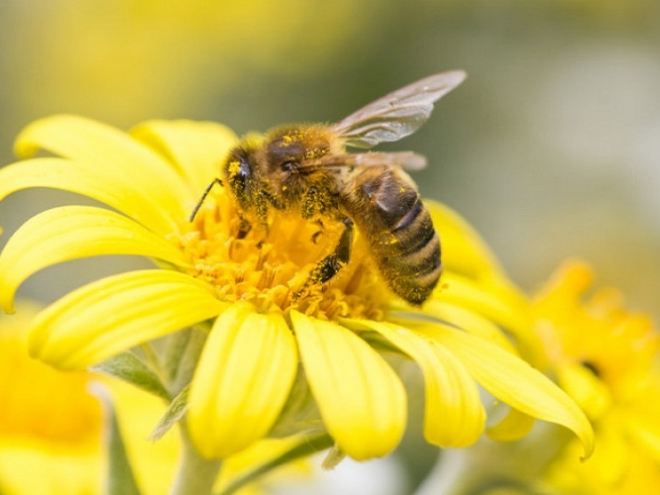Behavioral Neuroscience, lecture on Honey Bee Proboscis Extension Motor output
Honey Bee Conditioned Drinking
XIV. A Bee's First Foraging Trip
A. Arrival at a Flower - Inspection
1. Flower specific nectar oder (+ flower odor)
a. enter Antennae placode sensilla
i. diffuse through sensillum lymph
b. Bind to odorant binding proteins (OBP)
i. directed diffusion
c. OBP + odorant move to ORNs
d. OBP + odorant bind to olfactory receptor proteins (OR) on ORNs
2. triggers Antennae ORNs action potential
3. ORN AP to antennal lobe glomeruli
a. ORN ACh à nAChR on AL PN
4. AL PN à SEG proboscis-related motor neuron
a. AL ACh à nAChR on mandible abductor (M8) neuron
i. ORN ð AL PN ð ñ SEB M8 neuron ð M8 = reflexive motor pathway
b. M8 neuron ACh à nAChR on mandible abductor muscle à contracts
i. mandibles spread
5. proboscis extend mechanically
B. Specific Nectar-Odor pairing
1. ORN à AChà nAChR AL PN à AChà nAChR MB KC
a. ORN à AL PN à LH
b. via lAPT + mAPT
i. lAPT: AL à LH à MB KC
ii. mAPT: AL à MB KC à LH
c. odor signal NOT sufficient to potentiate downstream effector neurons
i. not enough alone to trigger Pe-1
2. Extended proboscis/glossa (ORN/AL/M8 neuron) enters nectar
a. Nectar sucrose activates chemoreceptors on GRN
b. GRN action potentialà ACh à nAChR on VUMmx1
i. GRN AP à ACh à nAChR AL PN àACh
c. AL PN ACh à nAChR on VUMmx1
i. VUMmx1 à OA à AmOA1
3. Binds to octopamine receptor AmOA1 in AL
a. OA à AmOA1 LH
b. OA à AmOA1 MB KC
4. Coincident ACh and OA signalling in MB KC
a. also in AL and LH
C. Gating Coincidence output - CS + US pairing produces:
1. MB KC nAChR ð ñ Vm ð ñ VGCC ð ñ Ca++
2. MB KC AmOA1 à GPq11 à IP3 à ⇧ Ca++
3. ññ Ca++ ð ññ rutAC
a. ññ rutAC ð ññ cAMP ð ññ PKA ð ññ pAmCREB ð ññ CRE activation
i. ññ CRE ð ññ ubiquitin hydrolase ð ññ PKA
1) ññ PKA ð ññ pAmCREB ð ññ CRE
4. ññ CRE ð ññ C/EBP ð ññ EF1a
a. ññ formation of new synapses
b. similar coincidence effects at LH
5. New synapses potentiates Pe-1 signal output
a. and LH signal output
6. Pe-1 and LH projections converge on the SEG M8 motor neurons
a. doubles the signal strength on M8 neurons
i. another kind of potentiation
b. AmOA1-facilitated PE-1 + LH potentiation adds to the strength of convergence
i. ññññ M8 neuron potentiation
c. proboscis stays extended
D. Drinking is enabled by continued proboscis/glossa extension
E. Coincidence + Aversion
1. CS + US convergence: ORN ð AL PN ð LH + MB KC
a. GRN ð SEG Maxillary ganglion VUMmx1 ðAL PN + LH + MB KC
2. Toxin: GRN "deterent" ð AL DA PN ð a lobe MB GABAergic neurons
a. GRN "deterent" ð AL DA ð AmD2 aMB GABA ðGABAA ð ò MB KC
b. GRN "deterent" ð AL inhibitory GABAergic local neurons (LN)
i. GRN "deterent" ð AL LN ð GABA ð GABAA ð ò AL PN
3. ð weak or blocked AL PN signal
4. ð weak or blocked MB KC signal
a. ð weak or blocked LH signal
5. NO Pe-1 or LH potentiation
a. no Pe-1 + LH potentiation of SEB M8 neuron
i. in Mandibular ganglion
6. labium and glossa retractor muscles M17, M20
a. can remove glossa/proboscis from toxic nectar
